Nutmeg Farming
Nutmeg (Myristica fragrans) tree is unique among spice plants as it produces two distinct and valuable spices from a single fruit—nutmeg and mace. Nutmeg is the dried seed of the apricot-like fruit, while mace is the thin, leathery, reddish aril that surrounds the seed coat. Both spices are renowned for their strong, aromatic fragrance and warm, resinous flavor, commonly used in culinary and medicinal applications.
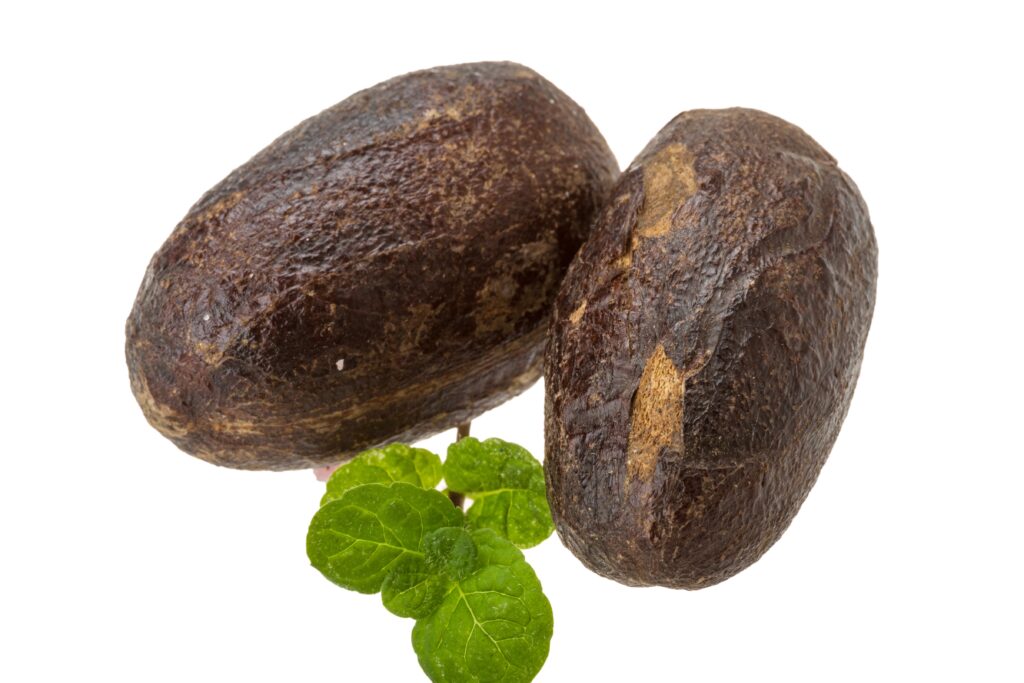
While nutmeg provides a robust and slightly sweet taste, mace is generally considered to have a finer, more delicate aroma, making it a prized ingredient in gourmet cooking and high-end spice blends.
Nutmeg farming profit per acre becomes significantly attractive once the plantation reaches maturity, with the break-even point typically achieved in Year 15, the start of the peak production phase.
At this stage, cumulative profits turn positive, as the Year 14 balance of -NPR 122,810 is offset by a Year 15 net gain of NPR 195,700, resulting in a surplus of NPR 72,890. The peak phase (Years 15–30) contributes over 90% of the 30-year profit, generating around NPR 195,700 annually.
Mature nutmeg trees beyond 30 years command even higher prices, up to NPR 1,500/kg—about 15% more than peak-phase rates. However, early years (6–8) may operate at a loss of approximately NPR 12,200 per year due to low yields, and suboptimal planting density (63 trees/acre vs. the recommended 120–180) may reduce total yield by around 50%.
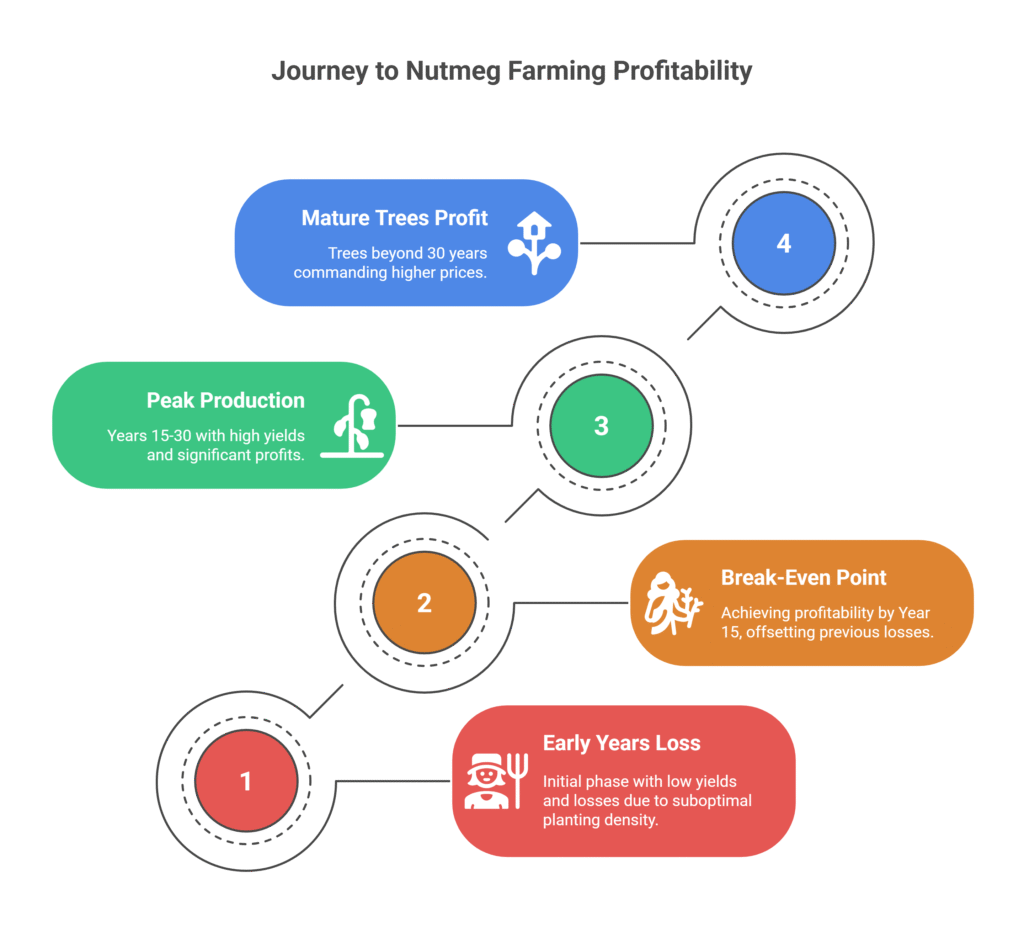
Additionally, risks such as pest outbreaks, irrigation failure, or market price volatility can impact profitability by 30–50%, highlighting the importance of proper management and planning in nutmeg cultivation.
Land Preparation
Land preparation for nutmeg cultivation involves several crucial steps to ensure optimal growth conditions. Initially, the land should be cleared of all existing vegetation, rocks, and debris. This is followed by deep ploughing (30–45 cm) and harrowing to break soil clods, enhance aeration, and achieve a fine tilth for better root penetration and water infiltration.
The field must then be leveled to facilitate uniform water distribution and minimize erosion; on steeper slopes exceeding 20%, contour terracing becomes essential. Since nutmeg is highly susceptible to waterlogging, an efficient drainage system—comprising deep main and sub-drains or raised beds in flat or heavy soils—is vital.
Finally, windbreaks such as Casuarina or Albizia should be established around the plantation’s perimeter in open areas to shield young trees from wind damage.
Soil Type
Nutmeg thrives best in deep (2–3 meters), well-drained, fertile loamy soils rich in organic matter. While sandy loam, clay loam, and lateritic soils can also be suitable, excellent drainage is essential to prevent waterlogging. The ideal soil pH ranges from 5.5 to 7.0, favoring slightly acidic to neutral conditions; extreme pH levels must be corrected using lime for acidity or gypsum/sulfur for alkalinity. Poorly drained, heavy clay, saline, or highly alkaline soils should be strictly avoided, as they can cause root rot and severely hinder plant growth.
Climatic Requirements
Nutmeg requires a warm, humid tropical climate with ideal temperatures ranging between 20°C and 30°C, as extremes below 10°C or above 35°C, and frost conditions, are harmful or fatal to the plant.
It thrives under abundant, well-distributed annual rainfall of 1500–3500 mm and high humidity levels above 70%, with a short dry spell of 1–3 months beneficial for flowering, provided drought stress is avoided.
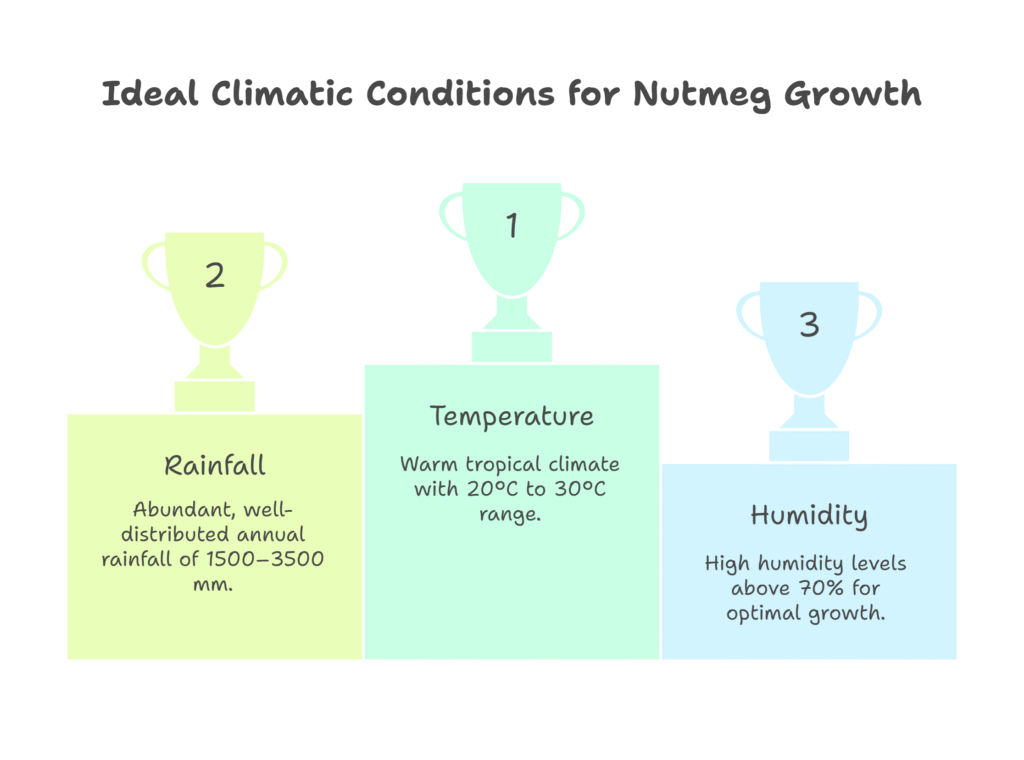
The crop performs best at lower elevations up to 600–700 meters, although higher tropical altitudes may be suitable if frost-free and consistently warm. While young seedlings need partial shade (50–60%), mature trees grow well in full sun, although some light shade is beneficial in hotter regions.
Major Cultivars
Nutmeg is primarily cultivated as the species Myristica fragrans, with few widely recognized named cultivars compared to other crops; however, selection efforts focus on traits such as high yield of quality nuts and mace, resistance to diseases like thread blight, fruit rot, and nutmeg wilt, as well as superior nut and mace characteristics including high essential oil content, desirable size, shape, and color.
Vigorous tree growth and well-structured canopies are also preferred traits. While regional types such as Indonesian, Grenadian, and Sri Lankan variants are common, named cultivars like ‘Vishwashree’, ‘Konkan Sugandha’, and ‘Konkan Swad’ have emerged from breeding programs, particularly in India.
Seedling Rate per Acre
Nutmeg cultivation requires approximately 63 seedlings per acre to ensure proper spacing, growth, and canopy development.
Planting
a). Planting Season
Nutmeg is typically planted during the monsoon to early winter months, from June to December, when soil moisture is adequate to support seedling establishment and growth.
b). Spacing
In nutmeg farming, the standard spacing is 8 meters × 8 meters. This spacing ensures proper canopy development, air circulation, and ease of intercultural operations.
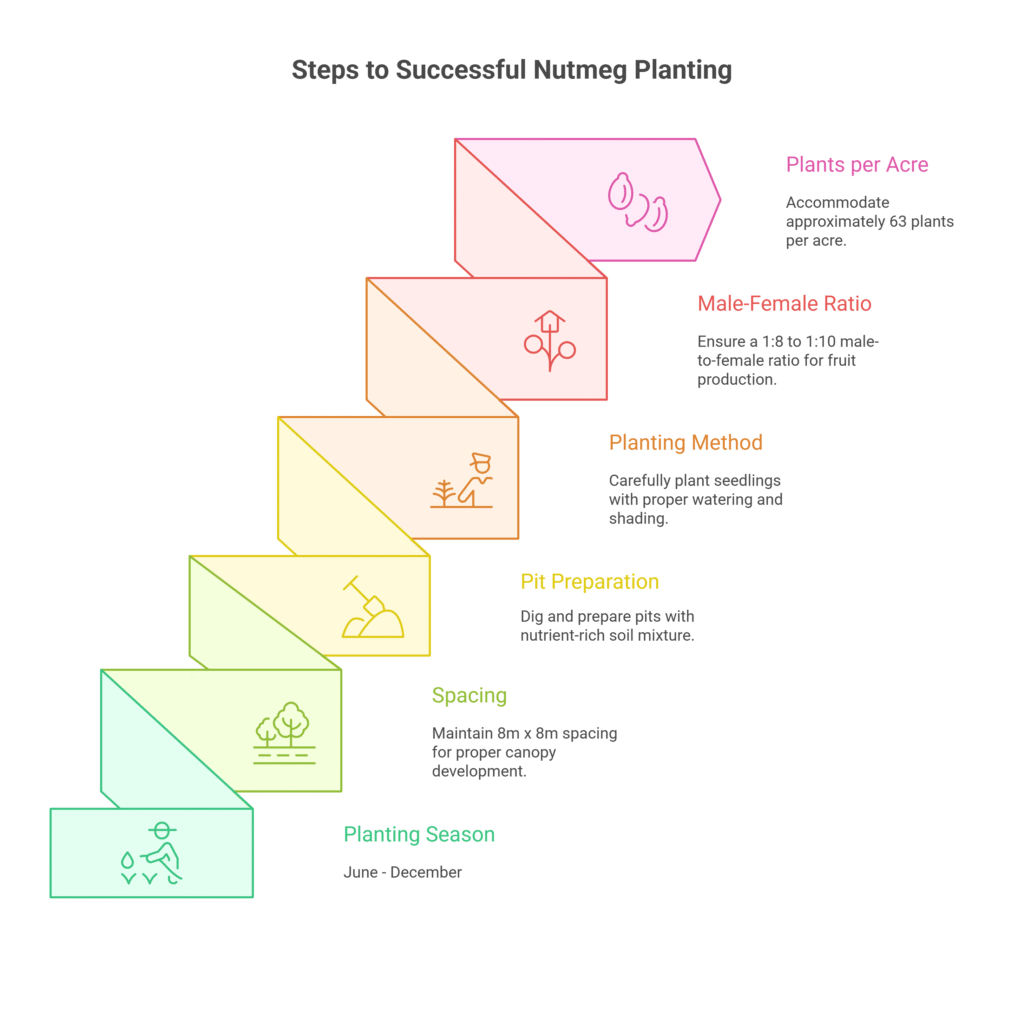
c). Pit Preparation
Pits for nutmeg planting should be dug at least 3–4 weeks prior to planting, with a recommended size of 60 cm × 60 cm × 60 cm. During excavation, topsoil and subsoil should be kept separate. The pits are then refilled with a mixture consisting of topsoil, 15–20 kg of well-rotted farmyard manure (FYM) or compost, 500 g of rock phosphate, 100 g of neem cake, and 50 g of Trichoderma viride. Once filled, the pits should be allowed to settle before transplanting the seedlings.
d). Planting Method
Before planting, nursery seedlings should be thoroughly watered a day in advance. Carefully lift healthy seedlings, typically 12–18 months old and 30–50 cm tall, ensuring a good ball of earth remains around the roots. In the center of each prepared pit, make a small hole and place the seedling at the same depth it was growing in the nursery.
Gently backfill with soil, firming it around the roots to remove any air pockets. Create a shallow basin around the seedling for effective watering, irrigate immediately and generously, and provide temporary shade using palm fronds or shade nets for the first few months to protect young plants from direct sunlight.
It is important to maintain a male-to-female ratio of 1:8 to 1:10, as only female trees bear fruit. Male trees can initially be planted as fillers at closer spacing to ensure adequate pollination and later removed or thinned out as the female trees mature and occupy full space.
e). Number of Plants per Acre
At the standard spacing of 8 m × 8 m, nutmeg farming accommodates approximately 63 plants per acre.
Intercropping
Intercropping is highly recommended during the early years of nutmeg cultivation, especially throughout the long juvenile phase of 7–9 years, as it provides additional income, shades the soil, suppresses weeds, and enhances soil fertility.
Suitable intercrops include banana, papaya, pineapple, cocoa, black pepper (trained on support trees), ginger, turmeric, taro, yam, and annual vegetables such as beans and peas, while tall, dense, or highly competitive crops should be avoided. In later years, once the nutmeg canopy matures, intercropping options become limited but can still include shade-tolerant species like ginger, turmeric, or cocoa, and black pepper vines may continue to be trained on support trees.
Irrigation
Irrigation is critical in nutmeg cultivation, particularly during the establishment phase (first 3 years) and during prolonged dry spells lasting more than 2–3 weeks.
While mature trees are more drought-tolerant, they still benefit from irrigation during dry periods to support consistent flowering and fruit development. Recommended irrigation methods include basin irrigation, drip irrigation (highly efficient), or micro-sprinklers, with care taken to avoid waterlogging.
In dry weather, young plants should be watered every 3–5 days, while mature trees require deep watering every 10–15 days, depending on soil moisture levels. Applying organic mulch—such as coconut husk, dry leaves, or straw—around the base (without touching the trunk) helps conserve moisture, suppress weeds, and regulate soil temperature.
Fertilizer and Manure
At the time of planting, incorporate generous amounts of organic matter—15–20 kg of FYM or compost along with rock phosphate—into each pit. For young plants aged 1–4 years, apply 10–20 kg FYM or compost along with 100 g nitrogen (N), 40 g phosphorus (P₂O₅), and 140 g potassium (K₂O) per plant annually, split into two applications: the first in May/June and the second in September/October.
For bearing trees aged 5 years and above, apply 20–50 kg FYM or compost along with 500 g N, 250 g P₂O₅, and 1000 g K₂O per plant per year, also split into two seasonal applications. Fertilizer rates should be adjusted based on soil test results and tree performance, and micronutrients like boron (B), zinc (Zn), and magnesium (Mg) may be added if deficiencies are observed. All fertilizers should be spread evenly within the drip circle, lightly incorporated into the soil, and kept away from direct contact with the trunk.
Weed Control
Controlling weeds is essential when growing nutmeg, especially around immature plants. Maintaining a weed-free area around each young tree that is 1 to 1.5 meters in diameter requires manual weeding, which can be done by hoeing or hand pulling. Mulching is a very good way to keep soil moisture levels high and inhibit weed growth.
Leguminous cover crops, such Calopogonium and Pueraria, can be planted in interrows to improve soil nitrogen and lessen weed pressure. Herbicide-based chemical weed control should be done very carefully; non-selective herbicides, such as glyphosate, should only be applied sparingly and in interrows or corridors, carefully positioned away from trees. Manual or mulching techniques should always be given priority close to the root zones, and pre-emergent herbicides are rarely advised near nutmeg trees.
Flowering and Fruit Management:
Flowering in nutmeg trees occurs year-round with seasonal peaks depending on the local climate, typically beginning 5–7 years after planting.
The small, pale yellow flowers are dioecious, meaning male and female flowers grow on separate trees, and pollination is primarily carried out by insects like small flies and beetles. The fruit, known as a nutmeg apple, is pendulous and peach-like, taking about 6–9 months to mature after flowering.
When ripe, it splits open along a natural ridge to reveal the brown seed (nutmeg) encased in a bright red, lacy aril (mace). Effective flowering and fruit management involves maintaining an appropriate male-to-female tree ratio for optimal pollination, ensuring balanced nutrition and irrigation during flowering and fruit development, promptly removing diseased or damaged fruits, and protecting developing fruits from pests.
Pest and Disease Management
Common Pests
a). Stem Borer
Stem borer larvae damage plants by tunneling into stems and branches; management requires removing and destroying infested branches, followed by injecting insecticide solutions (either a 0.1% carbaryl solution or a 0.05% dichlorvos solution) directly into bore holes and sealing them, applying 2-3% neem oil as a deterrent, and encouraging natural predators like parasitoid wasps for biological control.
b). Shoot Caterpillar/Leaf Miner
Young shoots and leaves are harmed by shoot caterpillars and leaf miners, which results in reduced growth. Pruning and destroying impacted plant portions is one way to manage them. For efficient management in cases of severe infestation, use pesticides such as carbaryl 50 WP at 2 g/liter or quinalphos 25 EC at 2 ml/liter of water, or spray neem oil (5 ml/liter of water).
c). Scale Insects & Mealybugs
Sap-sucking pests like mealybugs and scale insects damage plants and encourage the growth of sooty mold. Spraying neem oil (5 ml/liter), soap solution (1–2%), or pesticides like dimethoate 30 EC at 2 ml/liter or malathion 50 EC at 2 ml/liter of water are all effective management techniques. For long-term management, it’s also advised to support natural enemies like parasitoids and ladybird beetles.
d). Fruit Borers/Piercing Moths
Fruit borers and piercing moths attack developing fruits, causing internal damage and fruit drop. To manage them, regularly remove and destroy infested fruits to break the pest cycle. Apply insecticides like carbaryl 50 WP at 2 g/liter or quinalphos 25 EC at 2 ml/liter of water during the fruit-setting stage. Installing pheromone traps (10–12 per acre) also helps monitor and reduce adult moth populations effectively.
Common Diseases
a). Thread Blight (Marasmius spp.)
Thread blight, caused by Marasmius spp., appears as white fungal webbing on branches, leading to leaf drop and weakened plant growth. Management includes pruning and destroying infected branches to reduce disease spread, improving plant spacing and aeration, and spraying Bordeaux mixture (1%) or copper oxychloride 50 WP at 2.5 g/liter of water to effectively control the fungus and protect healthy plant parts.
b). Fruit Rot (Colletotrichum/Diplodia)
Fruit rot, caused by Colletotrichum and Diplodia species, affects ripe and fallen fruits, leading to decay and yield loss. Effective management involves regularly collecting and destroying infected fruits, avoiding waterlogging conditions to reduce fungal spread, and spraying copper-based fungicides such as copper oxychloride 50 WP at 2.5 g/liter or Bordeaux mixture (1%) during fruit development to prevent infection and protect healthy fruits.
c). Nutmeg Wilt (Fusarium spp.)
Nutmeg wilt, caused by Fusarium spp., leads to vascular blockage, wilting, and eventual death of trees. Management includes uprooting and destroying infected trees to prevent further spread, solarizing the soil using polythene sheets for 4–6 weeks to reduce fungal load, and avoiding replanting in previously infected areas.
Always use disease-free seedlings and ensure proper drainage to prevent water stagnation, which favors pathogen development. In nursery or early infection stages, drenching the soil with carbendazim 50 WP at 1 g/liter or copper oxychloride 50 WP at 2.5 g/liter of water can help suppress the pathogen.
d). Root Rot (Pythium/Phytophthora)
Root rot, caused by Pythium and Phytophthora species, is aggravated by waterlogged conditions and leads to root decay, stunted growth, and eventual plant death. Effective management is critical and begins with ensuring proper drainage and avoiding overwatering. Drench the soil with Bordeaux mixture (1%) or apply Trichoderma harzianum at 5 g per liter of water around the root zone to suppress the pathogens. Severely affected trees should be uprooted and destroyed to prevent disease spread.
Harvesting
Nutmeg fruits are ready for harvest 6–9 months after flowering, once they naturally split open along the suture to reveal the bright red mace and brown nut inside. Timely harvesting every 2–4 weeks during the peak season is essential to prevent spoilage or loss.
The harvest is primarily manual, using poles with hooks or nets to pick split fruits directly from the tree, or by frequently collecting fully ripe fallen fruits, ideally daily or every other day. After harvesting, the mace and nutmeg seed should be carefully separated immediately, taking care not to damage the delicate mace.
Yield
Nutmeg yield is highly variable and influenced by factors such as cultivar, tree age, climate, soil conditions, management practices, and seasonal variations. The first economic yield typically begins 7–9 years after planting, with peak production achieved between 15 and 30 years. Under proper care, nutmeg trees can remain productive for over 50 years.
| Tree Age Category | Fresh Fruit Yield (kg/acre/year) | Dry Nutmeg Yield (kg/acre/year) | Dry Mace Yield (kg/acre/year) |
| Years 7–12 | 1,500 – 4,500 kg | 200 – 600 kg | 20 – 60 kg |
| Mature (15+ years) | 4,000 – 15,000+ kg | 500 – 2,000 kg | 50 – 200 kg |
Cost of Investment Per Acre for Nutmeg Farming
| S.N. | Category | Cost |
| 1 | Land Preparation (plowing) | 15,000 |
| 2 | Plant Saplings (63 saplings) | 22,050 |
| 3 | Pit Digging | 10,000 |
| 4 | Planting | 2,000 |
| 5 | Fertilizers and Manure | 25,200 |
| 6 | Irrigation (Drip) | 75,000 |
| 7 | Weed Control | 7,000 |
| 8 | Pest & Disease Control | 5,000 |
| 9 | Harvesting | 5,000 |
| 10 | Miscellaneous Costs | 5,000 |
| Total Initial Investment | 171,250 |
Annual maintenance Cost per acre
From the second year onward, annual maintenance for a nutmeg plantation typically costs around NPR 50,000. This includes expenses for labor, irrigation, fertilization, pest and disease management, weeding, pruning, and other routine cultural practices necessary to support healthy tree growth and maximize future yields. Proper maintenance is essential during the juvenile phase to ensure strong establishment and long-term productivity of the trees.
Income from per Acre Nutmeg Farming
(Dried Nutmeg Yield)
| Year Range | Yield/Tree (kg) | Yield/Acre (kg) | Price (NRs/kg) | Annual Income (NRs) |
| 6–8 | 0.5 | 31.5 | 1,200 | 37,800 |
| 9–14 | 1.4 | 88.2 | 1,200 | 105,840 |
| 15–30 | 3 | 189 | 1,300 | 245,700 |
| 30+ | 2 | 126 | 1,500 | 189,000 |
Analysis of Nutmeg Farming Profit Per Acre
Profit Analysis (30-Year Projection)
| Phase | Years | Annual Net Cash Flow (NRs) | Cumulative Profit (NRs) | Key Observations |
| Initial Investment | 0 | -171,250 | -171,250 | One-time setup cost |
| Pre-Income (No Yield) | 1–5 | -50,000/year | -421,250 | Annual maintenance only (Year 2–5) |
| Early Yield (6–8) | 3 | 37,800 – 50,000 = -12,200 | -457,850 | Losses due to low yield |
| Growth (9–14) | 6 | 105,840 – 50,000 = 55,840 | -122,810 | Profit starts; recoups 26% of losses |
| Peak (15–30) | 16 | 245,700 – 50,000 = 195,700 | 3,009,390 | Major profitability (92% of total profit) |
| Decline (30+) | Per year | 189,000 – 50,000 = 139,000 | Ongoing | Sustainable high returns |
| 30-Year Total | ~3,009,390 | Excludes 30+ phase |
The break-even point in nutmeg cultivation is typically achieved in Year 15, marking the beginning of the peak production phase, when cumulative profits turn positive—with the Year 14 balance of -NPR 122,810 offset by a Year 15 net profit of NPR 195,700, resulting in a surplus of NPR 72,890.
The peak phase (Years 15–30) is the primary profit driver, generating around NPR 195,700 annually and contributing over 90% of total 30-year profits. Mature nutmeg trees beyond 30 years can fetch higher prices, up to NPR 1,500/kg—about 15% more than during the peak phase.
However, profitability is sensitive to several factors: early-stage losses of approximately NPR 12,200 per year during Years 6–8 due to low yields; suboptimal planting density (63 trees/acre vs. the recommended 120–180) reducing yield potential by around 50%; and risks such as pest outbreaks, market price fluctuations, or irrigation failures that could slash profits by 30–50%.
Sources
Food and Agriculture Organization (FAO)
University of California Agriculture & Natural Resources (UC ANR)
Punjab Agricultural University (PAU)
Tamil Nadu Agriculture University (TNAU) – Agritech portal
Indian Council of Agricultural Research (ICAR)
Nepal Agricultural Research Council (NARC)

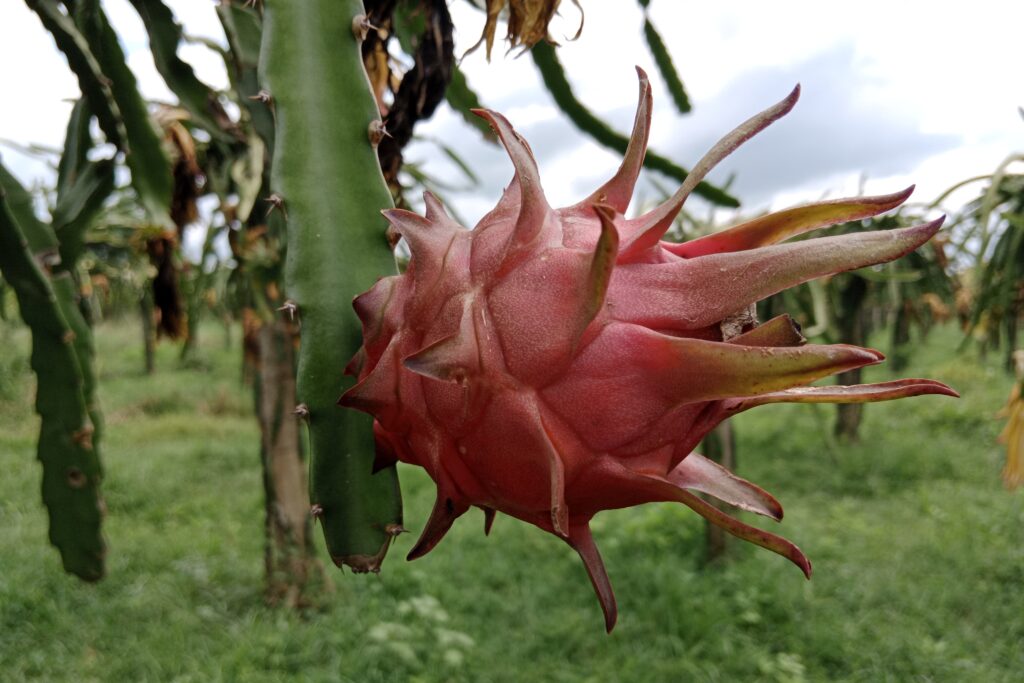

Pingback: Pistachio Nut Farming Profit Per Acre -